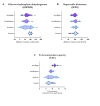Unraveling the acute sublethal effects of acetamiprid on honey bee neurological redox equilibrium
- PMID: 39528614
- PMCID: PMC11554660
- DOI: 10.1038/s41598-024-79274-6
Unraveling the acute sublethal effects of acetamiprid on honey bee neurological redox equilibrium
Erratum in
-
Author Correction: Unraveling the acute sublethal effects of acetamiprid on honey bee neurological redox equilibrium.Sci Rep. 2024 Nov 28;14(1):29592. doi: 10.1038/s41598-024-81264-7. Sci Rep. 2024. PMID: 39609508 Free PMC article. No abstract available.
Abstract
Understanding the off-target effects of neonicotinoid insecticides, including acetamiprid, which is the most commonly applied agricultural chemical, is crucial as it may be an important factor of negative impact on pollinator insects causing a number of problems such as colony collapse disorder (CCD) of honey bees. While CCD is known as a multifactorial disease, the role of pesticides in this context is not negligible. Therefore, it is essential to gain a deeper comprehension of the mechanisms through which they function. The aim of this research was to study the effects of sublethal acetamiprid doses on honey bees, specifically focusing on the redox homeostasis of the brain. According to our findings, it can be confirmed that acetamiprid detrimentally impacts the redox balance of the brain increasing hydrogen peroxide and malondialdehyde levels, suggesting consequential lipid peroxidation and membrane damage as consequences. Moreover, acetamiprid had negative effects on the glutathione system and total antioxidant capacity, as well as key enzymes involved in the maintenance of redox homeostasis. In summary, it can be concluded that acetamiprid adversely affected the redox balance of the central nervous system of honey bees in our study. Our findings could potentially contribute to a better understanding of pesticide-related consequences and to improvement of bee health.
Keywords: Apis mellifera; Colony collapse disorder; Glutathione; Malondialdehyde; Neonicotinoids; Oxidative stress.
© 2024. The Author(s).
Conflict of interest statement
Figures



Similar articles
-
Redox metabolic disruptions in the honey bee brain following acute exposure to the pyrethroid deltamethrin.Sci Rep. 2025 Aug 3;15(1):28322. doi: 10.1038/s41598-025-14089-7. Sci Rep. 2025. PMID: 40754625 Free PMC article.
-
Sublethal acetamiprid doses negatively affect the lifespans and foraging behaviors of honey bee (Apis mellifera L.) workers.Sci Total Environ. 2020 Oct 10;738:139924. doi: 10.1016/j.scitotenv.2020.139924. Epub 2020 Jun 3. Sci Total Environ. 2020. PMID: 32531610
-
Effects of the neonicotinoid acetamiprid in syrup on Bombus impatiens (Hymenoptera: Apidae) microcolony development.PLoS One. 2020 Oct 29;15(10):e0241111. doi: 10.1371/journal.pone.0241111. eCollection 2020. PLoS One. 2020. PMID: 33119659 Free PMC article.
-
Pesticides and pollinator brain: How do neonicotinoids affect the central nervous system of bees?Eur J Neurosci. 2024 Oct;60(8):5927-5948. doi: 10.1111/ejn.16536. Epub 2024 Sep 11. Eur J Neurosci. 2024. PMID: 39258341 Review.
-
Weight of evidence evaluation of a network of adverse outcome pathways linking activation of the nicotinic acetylcholine receptor in honey bees to colony death.Sci Total Environ. 2017 Apr 15;584-585:751-775. doi: 10.1016/j.scitotenv.2017.01.113. Epub 2017 Jan 24. Sci Total Environ. 2017. PMID: 28126277 Free PMC article. Review.
Cited by
-
Redox metabolic disruptions in the honey bee brain following acute exposure to the pyrethroid deltamethrin.Sci Rep. 2025 Aug 3;15(1):28322. doi: 10.1038/s41598-025-14089-7. Sci Rep. 2025. PMID: 40754625 Free PMC article.
-
Pesticide Contamination of Honey-Bee-Collected Pollen in the Context of the Landscape Composition in Latvia.Toxics. 2024 Nov 28;12(12):862. doi: 10.3390/toxics12120862. Toxics. 2024. PMID: 39771077 Free PMC article.
References
-
- Neov, B., Shumkova, R., Palova, N. & Hristov, P. The health crisis in managed honey bees (Apis mellifera). Which factors are involved in this phenomenon?. Biologia76, 2173–2180 (2021).
-
- Hristov, P., Shumkova, R., Palova, N. & Neov, B. Honey bee colony losses: Why are honey bees disappearing?. Sociobiology68, e5851 (2021).
-
- Dainat, B., vanEngelsdorp, D. & Neumann, P. Colony collapse disorder in Europe. Environ. Microbiol. Rep.4, 123–125 (2012). - PubMed
-
- Watson, K. & Stallins, J. A. Honey bees and colony collapse disorder: A pluralistic reframing. Geography Compass10, 222–236 (2016).
MeSH terms
Substances
Grants and funding
- FK146534/Ministry of Culture and Innovation of Hungary
- FK146534/Ministry of Culture and Innovation of Hungary
- RRF-2.3.1-21-2022-00001/Recovery and Resilience Facility, National Recovery Fund
- RRF-2.3.1-21-2022-00001/Recovery and Resilience Facility, National Recovery Fund
- SRF-001/University of Veterinary Medicine
LinkOut - more resources
Full Text Sources

